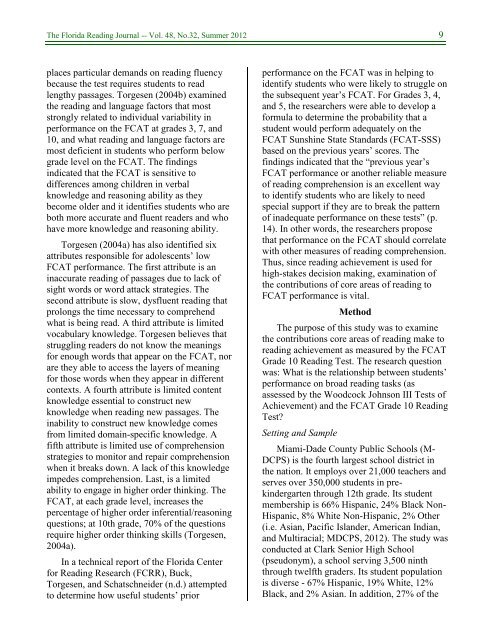PDF (Adobe Reader) - Florida Reading Association
PDF (Adobe Reader) - Florida Reading Association
PDF (Adobe Reader) - Florida Reading Association
You also want an ePaper? Increase the reach of your titles
YUMPU automatically turns print PDFs into web optimized ePapers that Google loves.
The <strong>Florida</strong> <strong>Reading</strong> Journal -- Vol. 48, No.32, Summer 2012 9<br />
places particular demands on reading fluency<br />
because the test requires students to read<br />
lengthy passages. Torgesen (2004b) examined<br />
the reading and language factors that most<br />
strongly related to individual variability in<br />
performance on the FCAT at grades 3, 7, and<br />
10, and what reading and language factors are<br />
most deficient in students who perform below<br />
grade level on the FCAT. The findings<br />
indicated that the FCAT is sensitive to<br />
differences among children in verbal<br />
knowledge and reasoning ability as they<br />
become older and it identifies students who are<br />
both more accurate and fluent readers and who<br />
have more knowledge and reasoning ability.<br />
Torgesen (2004a) has also identified six<br />
attributes responsible for adolescents‟ low<br />
FCAT performance. The first attribute is an<br />
inaccurate reading of passages due to lack of<br />
sight words or word attack strategies. The<br />
second attribute is slow, dysfluent reading that<br />
prolongs the time necessary to comprehend<br />
what is being read. A third attribute is limited<br />
vocabulary knowledge. Torgesen believes that<br />
struggling readers do not know the meanings<br />
for enough words that appear on the FCAT, nor<br />
are they able to access the layers of meaning<br />
for those words when they appear in different<br />
contexts. A fourth attribute is limited content<br />
knowledge essential to construct new<br />
knowledge when reading new passages. The<br />
inability to construct new knowledge comes<br />
from limited domain-specific knowledge. A<br />
fifth attribute is limited use of comprehension<br />
strategies to monitor and repair comprehension<br />
when it breaks down. A lack of this knowledge<br />
impedes comprehension. Last, is a limited<br />
ability to engage in higher order thinking. The<br />
FCAT, at each grade level, increases the<br />
percentage of higher order inferential/reasoning<br />
questions; at 10th grade, 70% of the questions<br />
require higher order thinking skills (Torgesen,<br />
2004a).<br />
In a technical report of the <strong>Florida</strong> Center<br />
for <strong>Reading</strong> Research (FCRR), Buck,<br />
Torgesen, and Schatschneider (n.d.) attempted<br />
to determine how useful students‟ prior<br />
performance on the FCAT was in helping to<br />
identify students who were likely to struggle on<br />
the subsequent year‟s FCAT. For Grades 3, 4,<br />
and 5, the researchers were able to develop a<br />
formula to determine the probability that a<br />
student would perform adequately on the<br />
FCAT Sunshine State Standards (FCAT-SSS)<br />
based on the previous years‟ scores. The<br />
findings indicated that the “previous year‟s<br />
FCAT performance or another reliable measure<br />
of reading comprehension is an excellent way<br />
to identify students who are likely to need<br />
special support if they are to break the pattern<br />
of inadequate performance on these tests” (p.<br />
14). In other words, the researchers propose<br />
that performance on the FCAT should correlate<br />
with other measures of reading comprehension.<br />
Thus, since reading achievement is used for<br />
high-stakes decision making, examination of<br />
the contributions of core areas of reading to<br />
FCAT performance is vital.<br />
Method<br />
The purpose of this study was to examine<br />
the contributions core areas of reading make to<br />
reading achievement as measured by the FCAT<br />
Grade 10 <strong>Reading</strong> Test. The research question<br />
was: What is the relationship between students‟<br />
performance on broad reading tasks (as<br />
assessed by the Woodcock Johnson III Tests of<br />
Achievement) and the FCAT Grade 10 <strong>Reading</strong><br />
Test<br />
Setting and Sample<br />
Miami-Dade County Public Schools (M-<br />
DCPS) is the fourth largest school district in<br />
the nation. It employs over 21,000 teachers and<br />
serves over 350,000 students in prekindergarten<br />
through 12th grade. Its student<br />
membership is 66% Hispanic, 24% Black Non-<br />
Hispanic, 8% White Non-Hispanic, 2% Other<br />
(i.e. Asian, Pacific Islander, American Indian,<br />
and Multiracial; MDCPS, 2012). The study was<br />
conducted at Clark Senior High School<br />
(pseudonym), a school serving 3,500 ninth<br />
through twelfth graders. Its student population<br />
is diverse - 67% Hispanic, 19% White, 12%<br />
Black, and 2% Asian. In addition, 27% of the



